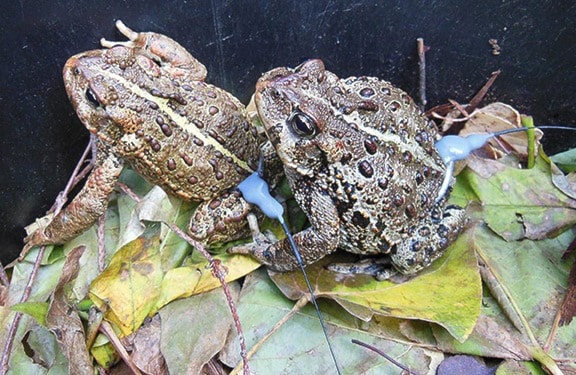A research team studying Western toads in the region is hoping to learn more about them and then share its knowledge with the greater community.
Group spokesperson Elke Wind said they have been actively looking for toads by scouring their known locations at night and doing pitfall trapping.
Once they catch them, they have some work to do before the toads are re-released.
“We record various things and then fit the toad with a transmitter and belt,” Wind explained. “Once released, we return to check on it a day or two later using a receiver to locate it. Then, the toad is tracked every four to six days throughout the fall and winter.”
So, if you see groups of two or three people wearing high visibility safety vests wandering around your neighbourhood, they may be tracking toads.
“We would appreciate your support and cooperation as our crew checks on toads as they move through the landscape,” Wind said.
So far the crew has outfitted six toads with transmitters.
“We had seven, but one slipped her belt so we’re down to six,” Wind explained.
Western toads are listed both provincially and federally as animals of special concern. Their populations have drastically declined on Vancouver Island.
Understanding what toads need for hibernation will help the future protection of the animals, which can be up to 12 centimetres long and either light to dark brown or olive-coloured, often with a cream-coloured stripe running down their back. They also have wart-like bumps on their skin.
Not too much is known about the terrestrial habitat requirements of the little creatures but the researchers are looking to learn more.
This multi-year project aims “to identify important terrestrial habitats on eastern Vancouver Island in order to contribute towards habitat protection and improved connectivity.”
In 2014 the group first began finding toads and outfitting them with transmitters in the greater Duncan area. They wanted to follow the animals to their winter hibernation sites.
“In total, eight adult toads (six males and two females) were captured and fitted with transmitters between Oct. 21 and Nov. 3, 2014. Of these, six were successfully tracked to hibernation sites. The toads entered into hibernation from Nov. 13 to 28, and remained there for approximately six to 13 weeks,” said a summary of the project’s work.
Toads hibernate on land but hidden away from frost.
“One toad hibernated under a downed log, one toad utilized two slash piles, and four of the toads appeared to hibernate subsurface (in cavities),” said the summary.
This year researchers hope to find and fit more Western toads with trackers in order to increase the sample size for their study.
“We are aiming for 15 before hibernation sets in around late November,” Wind said.
Curious about the work?
The group is hosting a public presentation at the Sahtlam Community Hall on Tues. Sept. 22. It begins at 7 p.m. with a talk and question period followed by a demonstration of toad handling procedures, how a transmitter is put on, and letting folks try their hand at finding a hidden transmitter placed outside in the trees using a receiver.
Those who would like to know more can email duncantoads@gmail.com for more information.
